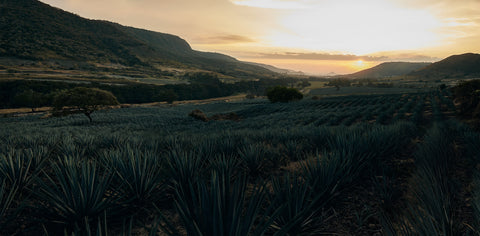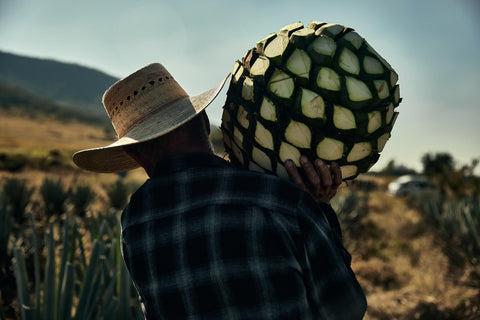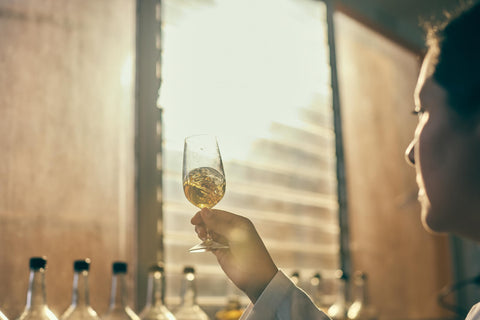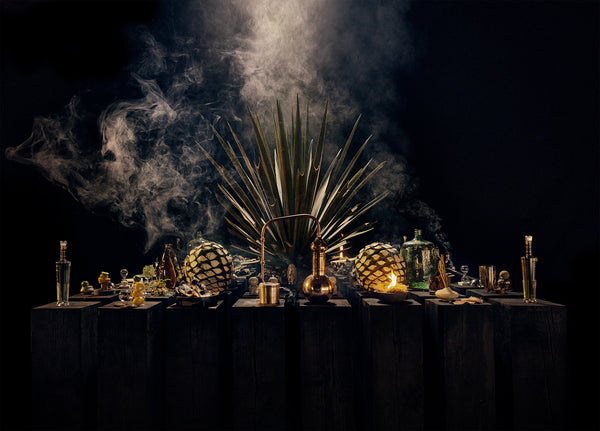What Makes a "True" Tequila? About Additive-Free Tequila

Ask a casual drinker what type of tequila they prefer, and they might tell you blanco, reposado or añejo. But ask a true tequila connoisseur what type they prefer, and they might say, “additive-free.”
Additive-free tequila is made with blue Weber agave, yeast and water – and that’s it. 100% of the flavor and color of additive-free tequila come from these ingredients, the distillation process and, if aged, the barrels in which the tequila rests.
For those who desire an elevated drink, appreciate true craftsmanship, seek transparency or simply enjoy the natural taste of cooked agave, additive-free tequila is the way to go. And whether you prefer to sip your tequila or love a well-crafted margarita, choosing additive-free tequila can improve your drinking experience in nearly every way.
Cierto is pure, natural “True” tequila – crafted with fully mature, estate-grown agave harvested and distilled by fourth and fifth generation agaveros (agave farmers) and gently matured in French Limousin oak casks. We like to say that Cierto is made as nature and time intended.
Cierto is the Most Awarded Tequila in History with over 800 international awards and medals, a clear sign the world’s leading spirits experts agree that this traditional, authentic process makes the world’s finest tequila.
Our in-depth look at additive-free tequila explains what a “True” tequila is (and isn’t), how it’s produced and what distinguishes it from tequila that contains additives or uses other process shortcuts.
What Makes a Spirit Tequila?
You can’t call a whiskey “scotch” unless it’s made in Scotland and you can’t call a sparkling wine “champagne” unless it’s made in Champagne, France – and adheres to production standards that are stringently upheld as those designations carry enormous significance.
The same is true of tequila. You cannot call agave-based spirits “tequila” unless they’re made in one of five states in Mexico: Jalisco, Guanajuato, Michoacán, Nayarit and Tamaulipas.
(The vast majority of tequila is made at the 150+ registered distilleries in Jalisco, the birthplace of tequila and the home of Cierto.) If you’re drinking a product labeled as a tequila, you know you’re drinking an authentic Mexican product.
The traditional tequila-making process starts with blue Weber agave plants, which are grown to full ripeness and harvested by hand. The agave piñas (hearts) are slowly cooked to release their natural sugars and mashed to extract their juice, which is poured into vats with yeast. After a period of fermentation, in which the yeast converts sugar to alcohol, the liquid is distilled into a spirit before bottling and/or aging.
This careful and time-tested process, which has been perfected over hundreds of years to showcase the amazing flavors and properties of agave, does not require the addition of any other ingredients. However, many distillers add them anyway, producing tequilas that contain one or several additives.
Learn More: Blanco vs. Reposado vs. Anejo: Distinguishing Tequila Expressions
What Additives May Be Used in Tequila?
It’s a little-known fact that according to Mexico’s Tequila Regulatory Council (CRT), the government agency that certifies and regulates the production and labeling of tequila, up to 1% of a tequila’s total weight may contain additives unless the distillery discloses it on the product’s label.
The CRT permits the use of four types of additives. Here’s a closer look at how they’re used.
Glycerin
Glycerin is a common thickening agent used to increase viscosity and artificially enhance a tequila’s mouthfeel. Because glycerin coats the tongue, it can make the tequila feel heavier.
Caramel Coloring
Some distillers use artificial caramel coloring to make their tequilas darker, mimicking the deeper, cognac tones of well-aged tequilas, which can lead consumers to believe that the tequila was aged for much longer than it actually was.
Oak Extract
Oak extract is an additive that can give tequilas some of the aromas and flavors that can only be gained from lengthy barrel aging. Some distilleries use it to avoid waiting out the full aging process.
Similar to caramel coloring, it can lead consumers to believe that a tequila underwent a longer aging process than it actually did. Caramel coloring and oak extract tend to be found in tequilas labeled as reposado, añejo or extra añejo.
Jarabe
Jarabe is a type of sugar-based syrup that can artificially sweeten the taste of tequila and impart other flavors not naturally found in mature agave. The CRT permits the use of many types of sugar additives, including artificial products such as aspartame and sucralose.
If your tequila tastes excessively like caramel, vanilla, or chocolate, it might contain jarabe. Even blanco tequilas that don’t use other additives can contain jarabe.
Why Do Many Distillers Resort to Using Additives?
Since the use of additives in compliance with CRT regulations does not need to be disclosed, there is no official list of all tequila brands containing additives. However, their use is suspected to be prevalent, representing the vast majority of tequila produced and many of the most popular brands.
There are different reasons why some distilleries might use additives in their products. Additives can artificially enhance a tequila’s flavor or “round out” imperfections in a spirit that’s made with immature agave or industrialized distillation methods. Additives can speed up the production process by imitating the look, aroma and flavor of a tequila that has been aged for much longer.
The traditional tequila-making process takes patience, takes time and can be expensive. Additives and other shortcuts can help the distillery to meet the increasingly high global demand for tequila. By using additives, they attempt to imitate the more complex flavor and appearance of a well-made, additive-free tequila and produce more bottles in less time, at a lower cost.
What Is a "True" Tequila?

In our view, a spirit that’s made to mimic the flavor of tequila (instead of deriving its flavors naturally) and is not transparent about it, isn’t a “True” tequila. A “True” tequila celebrates the multitude of factors that influence the taste of a traditionally distilled tequila, harnesses small differences in the process and applies painstaking skill to create a variety of expressions for drinkers to enjoy. Some of these factors include:
-
The mineral content and quality of the soil in which the agave is grown
-
Whether any vegetation or crops grow adjacent to or amidst the agave
-
The climate and elevation of the agave orchards
-
The age and sugar content of the agave
-
How and when the agave is harvested
-
How long the agave is cooked and under which conditions
-
How long the agave is fermented, the type of vat and the types of yeast
-
The equipment used to distill the agave and the proof of the distillate
-
The type, quality and amount of the water used
-
Whether the tequila is rested before bottling
-
The types of casks used to age the tequila
-
How long the tequila is aged before bottling and under which environmental conditions
-
The proportions in which different tequila batches are blended
-
And many more!
What Makes Cierto a "True" Tequila?
“Cierto” translates to “True,” and that’s the cornerstone of everything we believe and do.
All of the agave used to craft Cierto Tequila is estate-grown and harvested by Cierto’s Master Distillers, Enrique Fonseca and Sergio Mendoza – fourth and fifth generation agaveros, whose families are some of the largest and most respected growers in Mexico. As stewards of a 200-year-old farming legacy, they employ sustainable agricultural practices that enrich the soil and make for superior agave.
In the Jalisco Highlands, Enrique and Sergio cultivate their blue Weber agave in ancient, red clay soil and allow the plants to grow to full maturity before harvesting them one-by-one and bringing them to their distillery, La Tequileña (NOM 1146) in the small town of Tequila.
There, the agave are cut by hand, steam-cooked in low-pressure autoclaves (ovens) and fermented in open-air tanks. Both traditional copper pots and bespoke column stills are used to distill the fermented liquid, after which the tequila is either rested in stainless steel, if destined to become Cierto Blanco, or aged inside of French Limousin oak casks.
Finally, rare casks of various lineages are married together to create the ultimate blends for Cierto’s aged expressions – Reposado, Añejo and Extra Añejo.
No additives, artificial ingredients or other shortcuts are ever used in the creation of Cierto.
While this is a much more time-intensive and costly approach, it ultimately makes for tequila that is truer to the terroir of their orchards, the natural flavors of agave and honors the incredible tradition of tequila-making.
“True” tequila offers a purer, cleaner drinking experience and quite simply tastes the best. And that’s not just our view – tequila connoisseurs and judges of the world’s top spirits competitions have given Cierto more than 800 awards and medals, more than any tequila brand in history.
Why would anyone want to manipulate or contaminate this beautiful, natural product?
How Can You Identify Additives in Tequila?

If you usually drink your tequila in a cocktail, such as a margarita or paloma, you may not have noticed the presence of additives because the cocktail’s sweet and flavorful ingredients are masking them. But sip the tequila neat and you’ll find a distinct difference between those which contain additives and those which are additive-free.
Don’t be fooled by a label that says “100% agave,” “natural,” “organic” or “gluten free,” as tequilas carrying these designations may contain additives up to 1%. Remember, distillers aren’t required to disclose additives on the product’s label (unless they exceed 1% of the tequila’s weight), which unfortunately means that many don’t.
In general, the best way to determine if your favorite tequila uses additives is to train your senses.
You can start by nosing and tasting a few tequilas that are known to be additive-free. (More on that next.) You can compare them to a few mass-produced brands, which are much more likely to contain additives. It’s best to compare a blanco to a blanco, and so on.
If you’re accustomed to drinking tequila with additives, you might not recognize their presence at first, but a few side-by-side comparisons should highlight the stark difference between the pleasant, fresh aromas and flavors of pure agave versus those that have been artificially manipulated to be sweeter or more vanilla-forward.
Another, unscientific way to test for additives is to pour a few drops of tequila into your palm and rub your hands together. Wait a few seconds and see how your hands feel. If they feel dry, as if you only had water on your hands, then it’s probably additive-free. If they feel sticky, the tequila may contain additives such as glycerin or sugar syrup.
Next time you raise a glass of tequila, gently swirl it around and take notice of its “legs” – the spirit that sticks to and cascades down the sides of the glass. The legs of a blanco tequila travel quickly, while the legs of an añejo or extra añejo need more time to reach the bottom of the glass. If you’re drinking an aged tequila and the legs are moving fast, it might contain additives.
However, the only way to be sure that you’re drinking an additive-free tequila is to check if it’s been confirmed as such.
How Are Additive-Free Tequilas Confirmed?
Unfortunately, there’s no single entity charged with inspecting every batch of every tequila to officially verify the absence or presence of additives.
In 2023, the CRT added the “Natural and Free of Additives Certified Product” designation to its process. If a tequila product meets the requirements, it may bear the CRT’s additive-free designation on its label. However, as of the time of this writing, this newly-introduced process has not yet been articulated and a timeline for its rollout has not yet been set.
Due to this lack of information, many tequila drinkers prefer to check if their tequila has a confirmation from the popular app Tequila Matchmaker and its Additive-Free Alliance. To bear the Alliance’s mark and appear on Tequila Matchmaker’s confirmed additive-free list, their independent inspectors must conduct an extremely thorough distillery evaluation, which includes:
-
A tour of all areas of the distillery
-
Access to production log books that show all supplies purchased
-
Collection of samples of blanco tequila directly from the still
-
Collection of samples of aged tequilas directly from the barrels
-
Lab analysis of samples to detect any chemical or molecular traces of additives
-
Comparison of distillery samples to other samples purchased at retail
If a distillery produces some tequila brands that contain additives and others that do not, they must disclose that information. The Additive-Free Alliance designation will then be granted to the select brands that qualify. (To date, just over 100 brands have earned this designation, which is fewer than 4% of all tequila brands on the market today but is growing by the day.)
Is Additive-Free Tequila Better?
We believe so, and a growing legion of tequila drinkers agree.
Not only is additive-free, “True” tequila purer and cleaner tasting, it centers on the incredible, natural flavors of the fully mature agave, showcases the craftsmanship of the distillers and respects the authentic traditions and processes developed over hundreds of years. When you drink a glass of tequila, that’s what we believe you should be experiencing, not some arbitrarily chosen and artificially delivered flavor profile or convoluted backstory that masks a substandard product.
Additive-free tequilas generally take longer to produce and require greater skill, patience and more careful attention throughout the entire orchard-to-bottle process. They generally use agave that’s healthier because it’s farmed under better, more sustainable conditions and allowed to reach full maturity.
If you’re someone who wants to know exactly what you’re putting into your body, additive-free tequila is a must, as transparency is in short supply when you’re drinking a tequila that uses additives. You can always trust that the flavor of additive-free tequila comes solely from its ingredients (blue Weber agave, yeast and water), the distillation process and barrel maturation (if aged).
The growing additive-free tequila movement has changed the way people think about tequila and how they consume it, but the only way to fully understand and appreciate it is to try it for yourself.
To enjoy a pure, natural “True” tequila that’s also the Most Awarded Tequila in History, shop Cierto’s Private Collection and the Reserve Collection now.
Up Next: The Best Ways to Drink Authentic Tequila
About the Author
Jim Ruane is the Chief Growth Officer of Elevated Spirits and Cierto Tequila. During his 20-year beverage career, Jim has led some of the world’s most respected brands, has studied and taught the engineering, chemistry and cultural significance of spirits distillation and is one of the industry’s most dynamic leaders.






